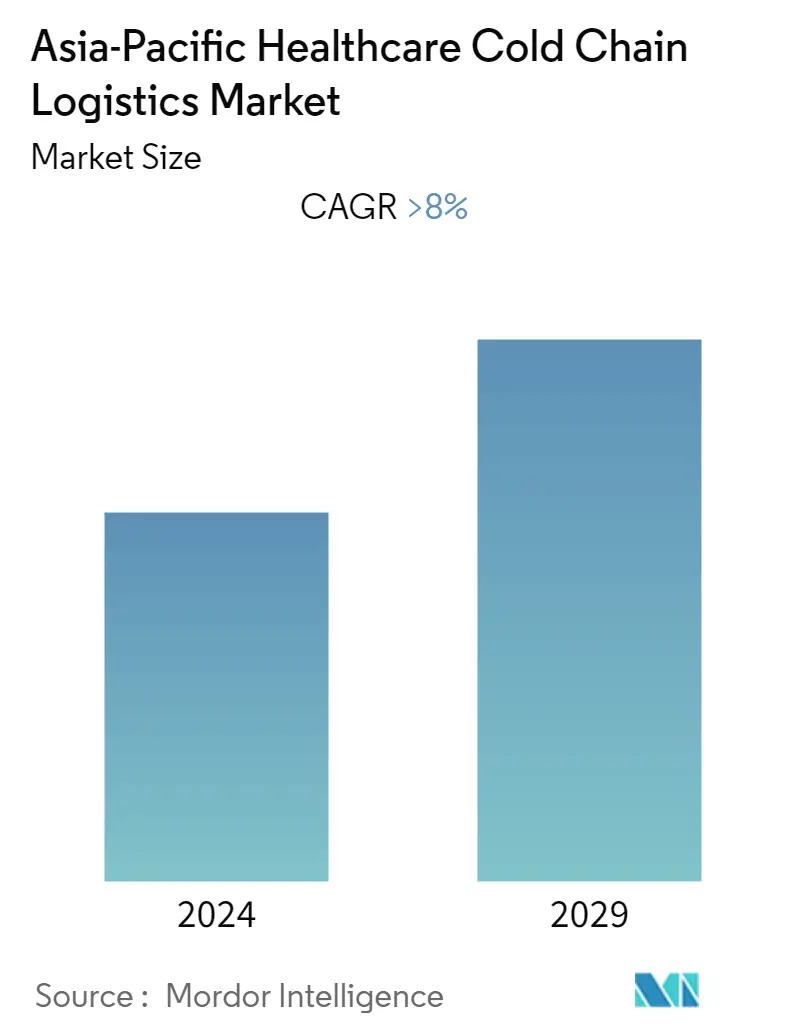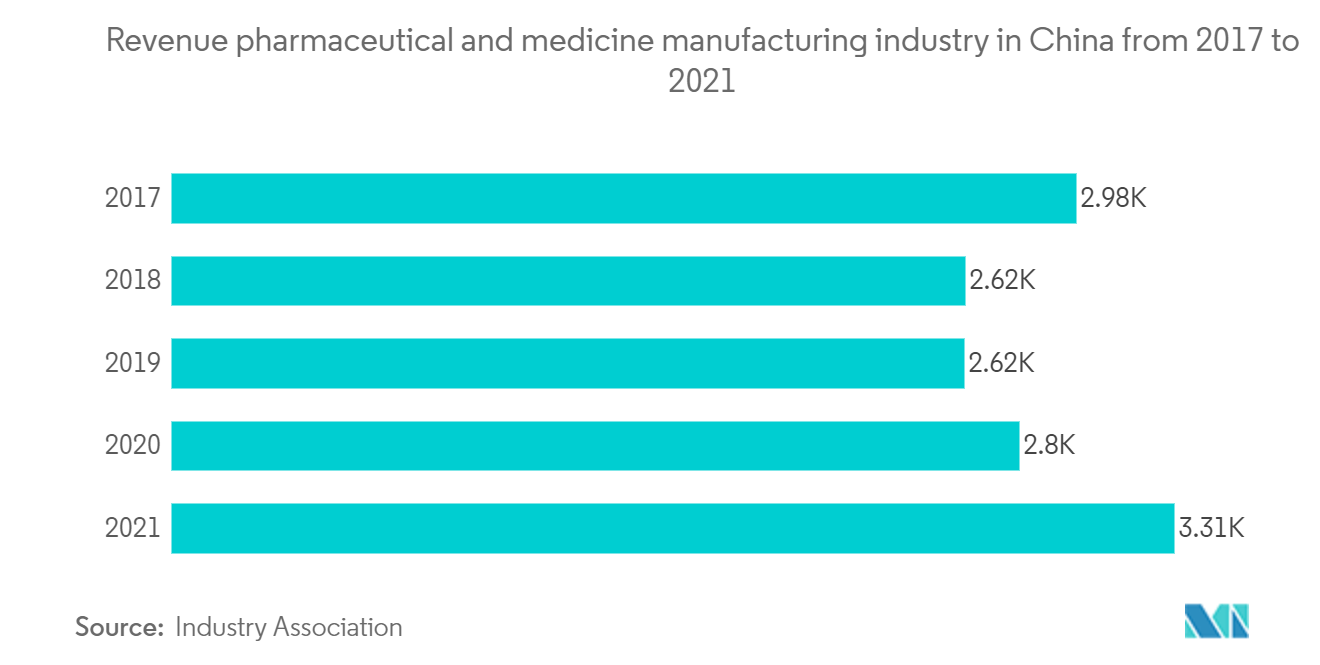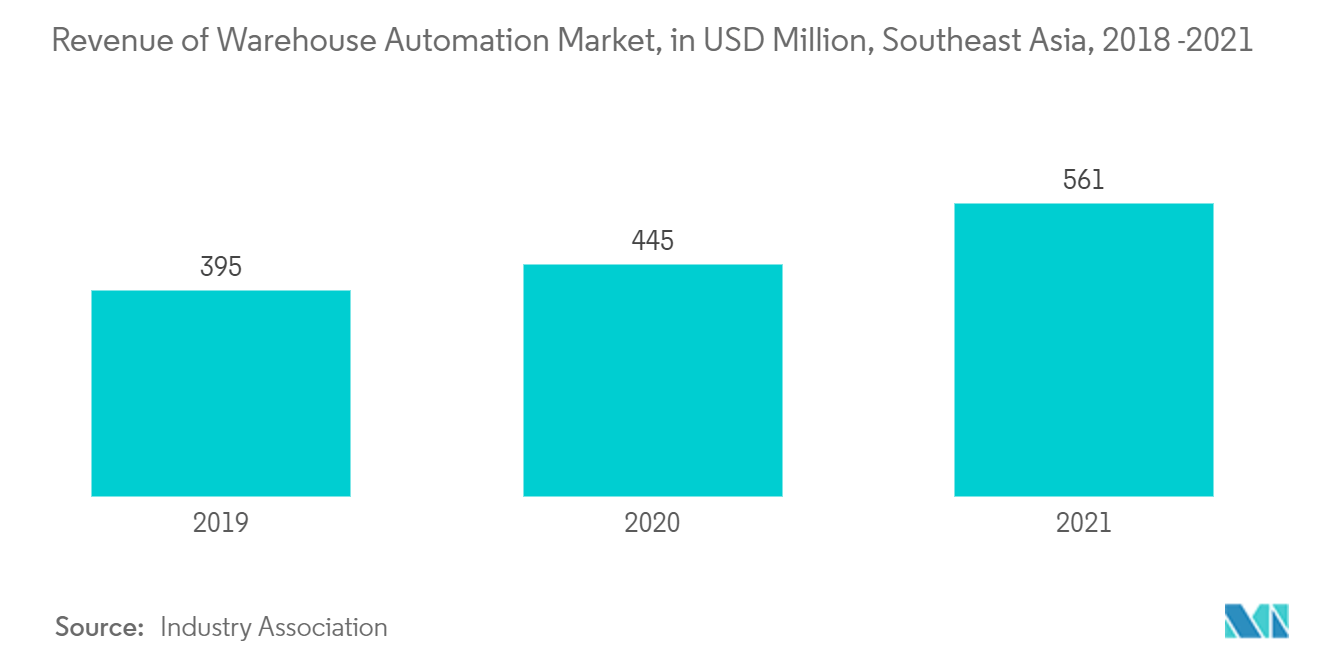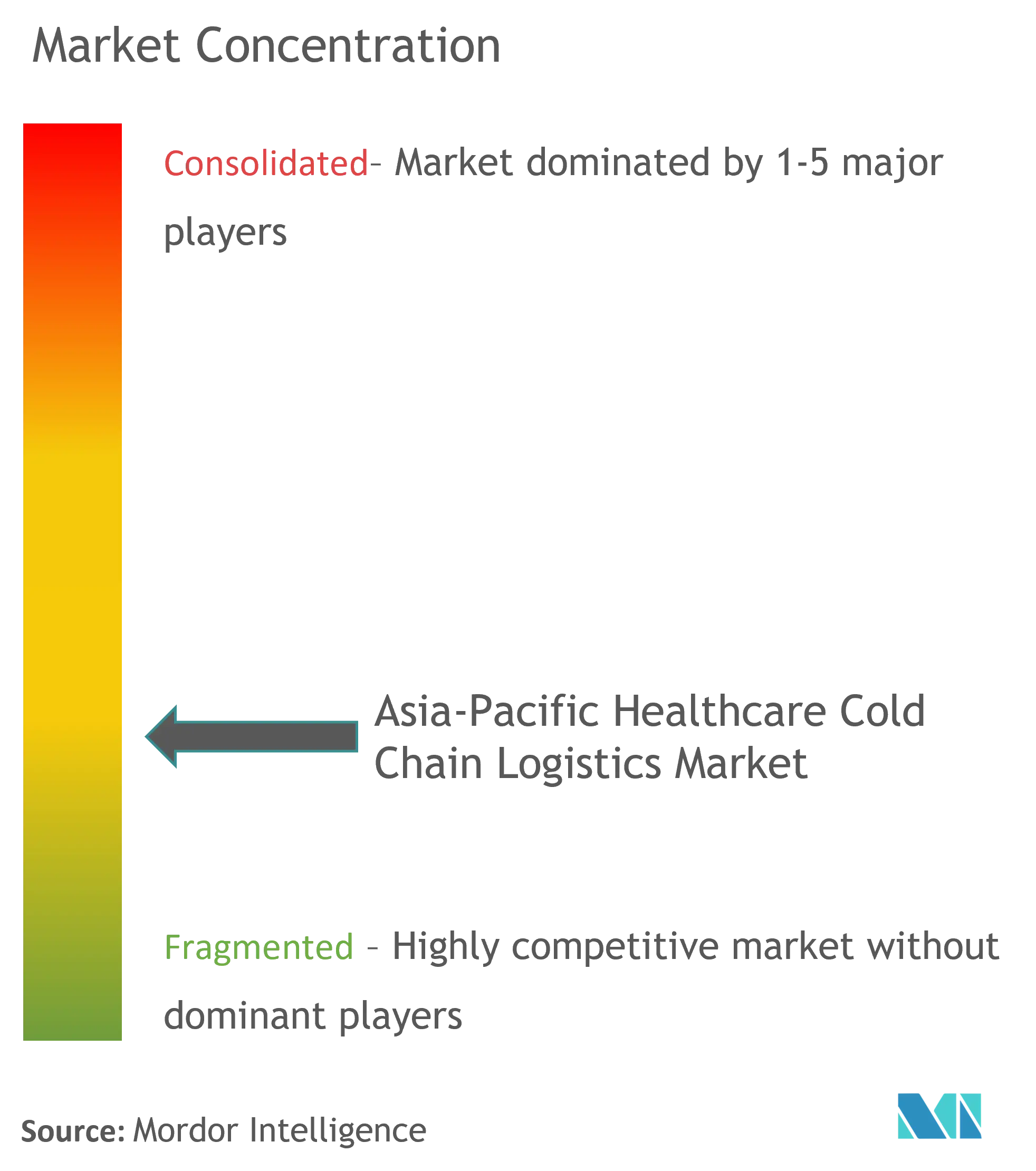Asia-Pacific Healthcare Cold Chain Logistics Market Size

| Study Period | 2019 - 2029 |
| Base Year For Estimation | 2023 |
| Forecast Data Period | 2024 - 2029 |
| Historical Data Period | 2019 - 2022 |
| CAGR | > 8.00 % |
| Market Concentration | Low |
Major Players
*Disclaimer: Major Players sorted in no particular order |
Need a report that reflects how COVID-19 has impacted this market and its growth?
Asia-Pacific Healthcare Cold Chain Logistics Market Analysis
During the time frame of the forecast, the Asia-Pacific healthcare cold chain logistics market is expected to grow at a CAGR of over 8%.
The COVID-19 pandemic has had a direct impact on healthcare cold chain logistics companies, which are involved in the storage, flow, and movement of goods.Because trade was limited during the COVID-19 pandemic, it had an effect on the supply chain of the healthcare cold chain industry. As a result, cold chain manufacturers focused on how they stored their products to make them last longer, which is likely to help the growth of the cold chain market.With more money in people's pockets and an aging population, healthcare spending in the region is growing quickly and will continue to be important to the growth of multinational pharmaceutical and biotechnology companies.
Several places in Asia and the Pacific, like India, China, Singapore, South Korea, etc., are also becoming popular places to outsource clinical trials, drug manufacturing, and pathology testing. Because of this, there is more demand for temperature-sensitive health products like vaccines, biopharmaceuticals, materials for clinical trials, etc. Because of these changes, there is more demand for cold storage facilities in the Asia-Pacific region, and more money is being spent on improving infrastructure. Some Asian governments are making changes to improve logistics services for the healthcare cold chain.
The growth of the healthcare cold chain logistics market is attributed to the increasing demand for biopharmaceuticals and vaccines that require cold chains and stricter government regulations for the efficient handling of temperature-sensitive pharmaceutical products. The flourishing pharmaceutical sector to serve the healthcare needs of the growing population is fueling the demand for healthcare cold chain logistics. Factors such as lack of standardization pertaining to operating procedures, security, temperature, pest control, and high operational costs restrain market growth.
Asia-Pacific Healthcare Cold Chain Logistics Market Trends
This section covers the major market trends shaping the APAC Healthcare Cold Chain Logistics Market according to our research experts:
Growth in the Pharmaceutical Sector Driving the Market
Pharmaceutical manufacturers in the Asia-Pacific region are increasingly focusing on product quality and sensitivity. Factors such as the development of complex biological-based medicines and the shipment of hormone treatments, vaccines, and complex proteins that require cold chain refinements result in the need for temperature-controlled transportation and warehousing. Long associated with the term "pharming," which refers to the rapid expansion of underdeveloped markets from modest starting points, are China, India, and other important Asian countries. But that's not the case now. Asia has had rapid expansion over the last ten years and is now the hub of the world's pharmaceutical business, driving advancement, growth, and future growth. China and Japan are currently the second- and third-largest pharmaceutical marketplaces in the world, respectively, in terms of market size and scope. Over the past ten years, China in particular has experienced robust and steady annual double-digit growth, supported by continued infrastructural development, rising healthcare investment and coverage, and a supportive regulatory framework. With their enormous populations and powerful drivers, India, Indonesia, Vietnam, and Thailand also exhibit great potential.
The temperature-controlled logistics of pharmaceuticals and medical devices is a part of the healthcare logistics industry that is growing very quickly.During the COVID-19 crisis, cold chain logistics is playing a vital role for the pharmaceutical sector, while increasing concern for health is expected to support the growth of the Asia-Pacific healthcare cold chain logistics market.
The Japanese pharmaceutical market is expanding to become the world's second-largest. Foreign direct investments (FDI) have steadily increased in the Japanese pharmaceutical sector over the years, assisting the country in establishing a global presence. Japan is home to four of the world's top 25 pharmaceutical companies.
An increase in the need for effective cold chain logistics services to maintain the quality of goods is fueling the growth of the market. In addition, the entire cold chain and logistics for the pharmaceutical industry are becoming more strategic and reliable. High-value pharmaceutical products are mostly shipped via cold chain solutions across the entire distribution network, thereby driving the growth of the market in Asia-Pacific. As Asia accounts for a larger and larger share of their global revenues and, more crucially, the majority of their growth, many multinational pharmaceutical firms are witnessing this personally. They normally receive 20% to 30% of their 2021 sales from Asia, with China accounting for almost half of that total.

Increase in Number of Refrigerated Warehouses
The COVID-19 pandemic has caused a big change in how the supply chain works. As a result, more high-end digital technologies are being used to improve operational efficiency and address health concerns.The changing logistics industry outlook, the requirement for substantial cost optimization, and optimum inventory management are anticipated to support the growth of the Asia-Pacific healthcare cold chain logistics market.
Japanese logistics companies are putting their years of experience to use in Southeast Asia by building modern warehouses with features like temperature controls to meet the changing needs of local consumers.As people's incomes rise in Asia, they expect their online shopping orders to arrive faster. This means that warehouses need to be handled automatically to save time and have strict temperature controls to keep goods fresh.
Thailand is the Asian country with the most advanced warehouses. Indonesia, with a population of over 270 million people, has enormous potential but has fallen behind in logistics development, owing in part to the transportation constraints posed by the country's numerous islands. However, demand from domestic market-focused enterprises is growing.
Businesses are investing millions of dollars in their cold chain operations to create effective, efficient, and reliable processes, as end-to-end cold chain security is the weak link in the system. Moreover, the number of refrigerated warehouses is increasing, owing to a surge in demand for food and pharmaceutical products in the Asia-Pacific region. Therefore, an increase in refrigerated warehouses is anticipated to boost the growth of the Asia-Pacific healthcare cold chain logistics market.

Asia-Pacific Healthcare Cold Chain Logistics Industry Overview
The Asia-Pacific healthcare cold chain logistics market is fragmented because of growing competition, new product launches, collaborative partnerships, and other strategic decisions made to improve operational efficiency. Some of the major players include DHL, CEVA Logistics, FedEx Corporation, and Cardinal Health. The key players have adopted the strategy of signing contracts and agreements for expanded regional reach and optimized operational costs. The market is highly competitive, with players competing and partnering to gain a substantial market share.
Asia-Pacific Healthcare Cold Chain Logistics Market Leaders
Cardinal Health
FedEx Corporation
DHL
CEVA Logistics
Agility
*Disclaimer: Major Players sorted in no particular order

Asia-Pacific Healthcare Cold Chain Logistics Market News
August 2022: A new master rental agreement (MRA) has been struck between DoKaSch Temperature Solutions and Japan Airlines (JAL) for the use of the temperature-controlled Opticooler as part of the cool service of the major Japanese airline. Using the active Opticooler as a dependable and effective supply chain solution for pharmaceutical shipments to and from Asia is now possible thanks to the MRA. DoKaSch and JAL are able to safely and effectively handle the nation's expanding needs for the delivery of vaccines and medications.
December 2022: The State Council of China has approved a five-year development plan for cold-chain logistics. Key focuses of the plan include making cold chains in China both greener and smarter. China plans to invest in infrastructure, including smart sorting equipment, logistics robots, and temperature monitors, as well as 5G and smart technologies like AI.
Asia-Pacific Healthcare Cold Chain Logistics Market Report - Table of Contents
1. INTRODUCTION
1.1 Study Deliverables
1.2 Study Assumptions
1.3 Scope of the Study
2. RESEARCH METHODOLOGY
2.1 Analysis Methodology
2.2 Research Phases
3. EXECUTIVE SUMMARY
4. MARKET INSIGHTS
4.1 Current Market Scenario
4.2 Technological Trends
4.3 Industry Value Chain Analysis
4.4 Government Regulations and Initiatives
4.5 Spotlight on Ambient/Temperature-controlled Storage
4.6 Insights into Refrigerants and Packaging Materials Used in Refrigerated Warehouses
4.7 Impact of COVID-19 on the Market
5. MARKET DYNAMICS
5.1 Drivers
5.2 Restraints
5.3 Opportunities
5.4 Industry Attractiveness - Porter's Five Forces Analysis
5.4.1 Bargaining Power of Suppliers
5.4.2 Bargaining Power of Consumers / Buyers
5.4.3 Threat of New Entrants
5.4.4 Threat of Substitute Products
5.4.5 Intensity of Competitive Rivalry
6. MARKET SEGMENTATION
6.1 By Product
6.1.1 Biopharmaceuticals
6.1.2 Vaccines
6.1.3 Clinical Trial Materials
6.2 By Services
6.2.1 Transportation
6.2.2 Storage
6.2.3 Packaging
6.2.4 Labeling
6.3 By End User
6.3.1 Hospitals and Clinics and Pharmaceuticals
6.3.2 Biopharmaceutical
6.3.3 Biotechnology Companies
6.4 By Country
6.4.1 China
6.4.2 Japan
6.4.3 India
6.4.4 Rest of Asia-Pacific
7. COMPETITIVE LANDSCAPE
7.1 Overview (Market Concentration and Major Players)
7.2 Company Profiles
7.2.1 Cardinal Health
7.2.2 FedEx Corporation
7.2.3 DHL
7.2.4 CEVA Logistics
7.2.5 Agility
7.2.6 Kuehne + Nagel
7.2.7 DB Schenker
7.2.8 Marken Ltd.
7.2.9 Cavalier Logistics
7.2.10 Envirotainer*
- *List Not Exhaustive
8. FUTURE OF THE MARKET
9. APPENDIX
9.1 GDP Distribution, by Activity - Key Countries
9.2 Insights into Capital Flows - Key Countries
9.3 Economic Statistics - Transport and Storage Sector and Contribution to Economy (Key Countries)
9.4 Freight Statistics (Mode, Product Category, etc.)
10. DISCLAIMER
Asia-Pacific Healthcare Cold Chain Logistics Industry Segmentation
Healthcare Cold chain logistics is the technology and process that allows temperature-sensitive goods and products, such as pharmaceutical drugs, to be transported safely throughout the supply chain.It impacts every stage of the supply chain, from purchase to transportation, storage, and last-mile delivery.
The Asia-Pacific healthcare cold chain logistics market is segmented by product (biopharmaceuticals, vaccines, and clinical trial materials), services (transportation, storage, packaging, and labeling), end user (hospitals and clinics, and pharmaceutical, biopharmaceutical, and biotechnology companies), and country (China, Japan, India, and the Rest of Asia-Pacific). The report offers market size and forecast values (in USD billions) for all the above segments.
| By Product | |
| Biopharmaceuticals | |
| Vaccines | |
| Clinical Trial Materials |
| By Services | |
| Transportation | |
| Storage | |
| Packaging | |
| Labeling |
| By End User | |
| Hospitals and Clinics and Pharmaceuticals | |
| Biopharmaceutical | |
| Biotechnology Companies |
| By Country | |
| China | |
| Japan | |
| India | |
| Rest of Asia-Pacific |
Asia-Pacific Healthcare Cold Chain Logistics Market Research FAQs
What is the current Asia-Pacific Healthcare Cold Chain Logistics Market size?
The Asia-Pacific Healthcare Cold Chain Logistics Market is projected to register a CAGR of greater than 8% during the forecast period (2024-2029)
Who are the key players in Asia-Pacific Healthcare Cold Chain Logistics Market?
Cardinal Health, FedEx Corporation, DHL, CEVA Logistics and Agility are the major companies operating in the Asia-Pacific Healthcare Cold Chain Logistics Market.
What years does this Asia-Pacific Healthcare Cold Chain Logistics Market cover?
The report covers the Asia-Pacific Healthcare Cold Chain Logistics Market historical market size for years: 2019, 2020, 2021, 2022 and 2023. The report also forecasts the Asia-Pacific Healthcare Cold Chain Logistics Market size for years: 2024, 2025, 2026, 2027, 2028 and 2029.
Asia-Pacific Healthcare Cold Chain Logistics Industry Report
Statistics for the 2024 Asia-Pacific Healthcare Cold Chain Logistics market share, size and revenue growth rate, created by Mordor Intelligence™ Industry Reports. Asia-Pacific Healthcare Cold Chain Logistics analysis includes a market forecast outlook 2029 and historical overview. Get a sample of this industry analysis as a free report PDF download.
